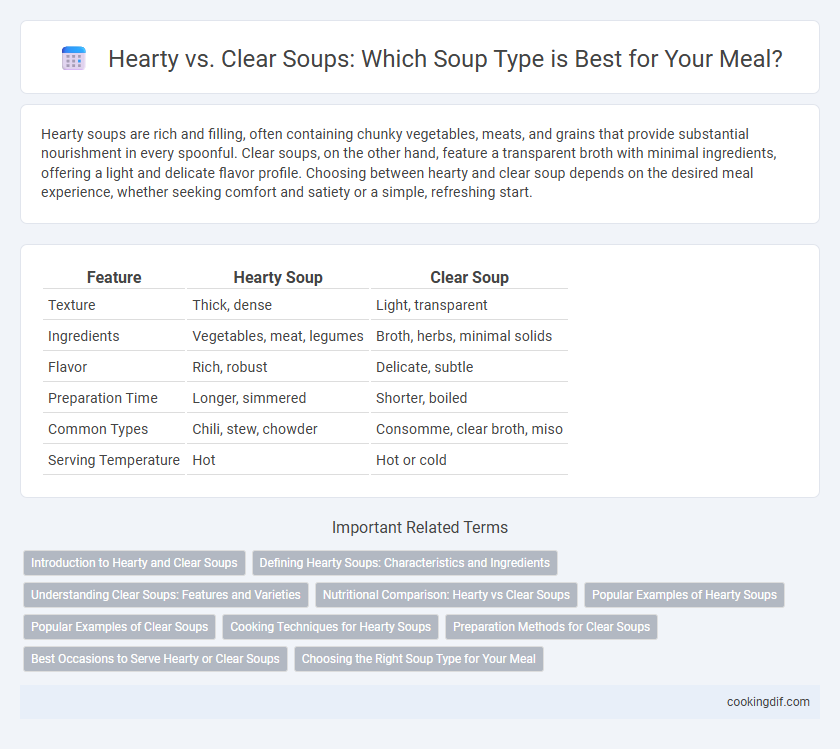Hearty soups are rich and filling, often containing chunky vegetables, meats, and grains that provide substantial nourishment in every spoonful. Clear soups, on the other hand, feature a transparent broth with minimal ingredients, offering a light and delicate flavor profile. Choosing between hearty and clear soup depends on the desired meal experience, whether seeking comfort and satiety or a simple, refreshing start.
Table of Comparison
| Feature | Hearty Soup | Clear Soup |
|---|---|---|
| Texture | Thick, dense | Light, transparent |
| Ingredients | Vegetables, meat, legumes | Broth, herbs, minimal solids |
| Flavor | Rich, robust | Delicate, subtle |
| Preparation Time | Longer, simmered | Shorter, boiled |
| Common Types | Chili, stew, chowder | Consomme, clear broth, miso |
| Serving Temperature | Hot | Hot or cold |
Introduction to Hearty and Clear Soups
Hearty soups feature thick textures packed with robust ingredients like vegetables, meats, and legumes, providing substantial nourishment and warmth. Clear soups are characterized by their transparent broths, often made from simmered bones or vegetables, offering a light, flavorful base often used as appetizers or palate cleansers. Both types serve distinct culinary purposes, balancing richness and clarity in diverse dining experiences.
Defining Hearty Soups: Characteristics and Ingredients
Hearty soups feature thick, robust textures with chunky ingredients like root vegetables, beans, and meat, offering rich, sustaining flavors that are designed to be filling and nutritious. These soups often use a creamy or broth-based liquid enriched with seasonings to enhance their depth, creating a dish that serves as a complete meal. Common examples of hearty soups include beef stew, lentil soup, and clam chowder, known for their dense consistency and generous portions.
Understanding Clear Soups: Features and Varieties
Clear soups are characterized by their transparent broth, made by simmering meat, vegetables, or bones to extract rich flavors without the use of thickening agents. Common varieties include consomme, a refined and clarified broth, and bouillon, a simple, lightly seasoned stock. These soups emphasize lightness and purity of taste, making them a versatile base for multiple culinary applications.
Nutritional Comparison: Hearty vs Clear Soups
Hearty soups contain higher amounts of protein, fiber, and essential vitamins due to ingredients like meats, beans, and vegetables, making them more nutrient-dense than clear soups. Clear soups, often broth-based with minimal solid components, are lower in calories and sodium but provide less macronutrients and micronutrients. The choice between hearty and clear soups impacts dietary goals, with hearty soups supporting satiety and nutrient intake, while clear soups aid hydration and are easier to digest.
Popular Examples of Hearty Soups
Hearty soups are characterized by thick, rich broths filled with substantial ingredients like meats, beans, and root vegetables, providing a filling and nutritious meal. Popular examples of hearty soups include clam chowder, beef stew, and lentil soup, each offering robust flavors and diverse textures. Unlike clear soups such as consomme or broth, hearty soups serve as complete meals rather than light starters.
Popular Examples of Clear Soups
Clear soups, characterized by their transparent broth and light flavor, include popular examples such as consomme, chicken broth, and miso soup. These soups are known for their delicate taste and are often used as a base for more complex dishes or served as a light starter. Popular clear soups emphasize simplicity and clarity, differentiating them from hearty soups, which are thicker and loaded with ingredients like vegetables, meat, or grains.
Cooking Techniques for Hearty Soups
Hearty soups rely on slow simmering techniques to develop deep, rich flavors and tenderize tougher cuts of meat, root vegetables, and legumes, maximizing nutrient extraction and texture. Techniques such as sweating aromatics in fat before adding broth, followed by extended cooking at low heat, enhance the soup's complexity and body. In contrast, clear soups use brief simmering and careful skimming to maintain a transparent, light broth without cloudiness or sediment.
Preparation Methods for Clear Soups
Clear soups require precise preparation methods to achieve their transparent appearance and delicate flavor. Typically made by simmering bones, meat, or vegetables slowly and then straining the broth to remove solids and impurities, these soups rely on techniques like gentle skimming and careful clarification using egg whites or gelatin. Maintaining low heat throughout the process prevents clouding, resulting in a soup that is light yet richly infused with subtle tastes.
Best Occasions to Serve Hearty or Clear Soups
Hearty soups, rich in ingredients like meat, beans, and root vegetables, are ideal for cold weather, comforting meals, and occasions requiring substantial nourishment such as family dinners or post-workout recovery. Clear soups, often broth-based with minimal solids, suit warm weather, light appetites, and elegant gatherings like formal luncheons or as a precursor to multi-course meals. Selecting between hearty and clear soups depends on the season, dietary needs, and the dining context, optimizing flavor balance and guest satisfaction.
Choosing the Right Soup Type for Your Meal
Hearty soups, rich in proteins and vegetables, provide a filling meal ideal for colder seasons or when seeking comfort food. Clear soups, typically broths or consommes, offer a light, flavorful option that works well as appetizers or for those on a low-calorie diet. Selecting the right soup type depends on nutritional needs, meal timing, and the desired level of satiation.
Hearty vs Clear for soup type Infographic

 cookingdif.com
cookingdif.com